Kremlin officials are reportedly demanding that Ukraine cede to Russia strategically vital unoccupied territory in Donetsk Oblast and freeze the frontline in other areas as part of a ceasefire agreement. The surrender of the rest of Donetsk Oblast as the prerequisite of a ceasefire with no commitment to a final peace settlement ending the war would force Ukraine to abandon its “fortress belt,” the main fortified defensive line in Donetsk Oblast since 2014, with no guarantee that fighting will not resume. Putin’s reported proposal reportedly demands that Ukraine concede this critical defensive position, which Russian forces currently have no means of rapidly enveloping or penetrating, apparently in exchange for nothing. The precise terms of Putin’s position remain unclear as of August 9; however, Trump Administration officials, particularly US Special Envoy for the Middle East Steve Witkoff, have offered four different presentations of Putin’s terms.
- The fortress belt is made up of four large cities and several towns and settlements that run north to south along the H-20 Kostyantynivka-Slovyansk highway, with a total pre-war population of over 380,537 people. The belt is 50 kilometers long (roughly 31 miles, about the distance between Washington, D.C., and Baltimore, Maryland).
- Ukraine has spent the last 11 years pouring time, money, and effort into reinforcing the fortress belt and establishing significant defense industrial and defensive infrastructure in and around these cities.
- Slovyansk and Kramatorsk form the northern half of the fortress belt and serve as significant logistics hubs for Ukrainian forces defending in Donetsk Oblast. Druzhkivka, Oleksiyevo-Druzhkivka, and Kostyantynivka serve as the southern half of the fortress belt.
- Ukrainian forces first began building up defensive positions in and around these cities after retaking them from pro-Russian proxy forces who attacked and seized Slovyansk, Kramatorsk, Druzhkivka, and Kostyantynivka in April 2014.
- Russia’s failure to seize Slovyansk in 2022 and ongoing struggles to envelop the fortress belt underscore the success of Ukraine’s long-term efforts to reinforce the fortress belt cities.
- Russian forces are currently still attempting to envelop the fortress belt from the southwest and are engaged in an effort to seize it that would likely take several years to complete.
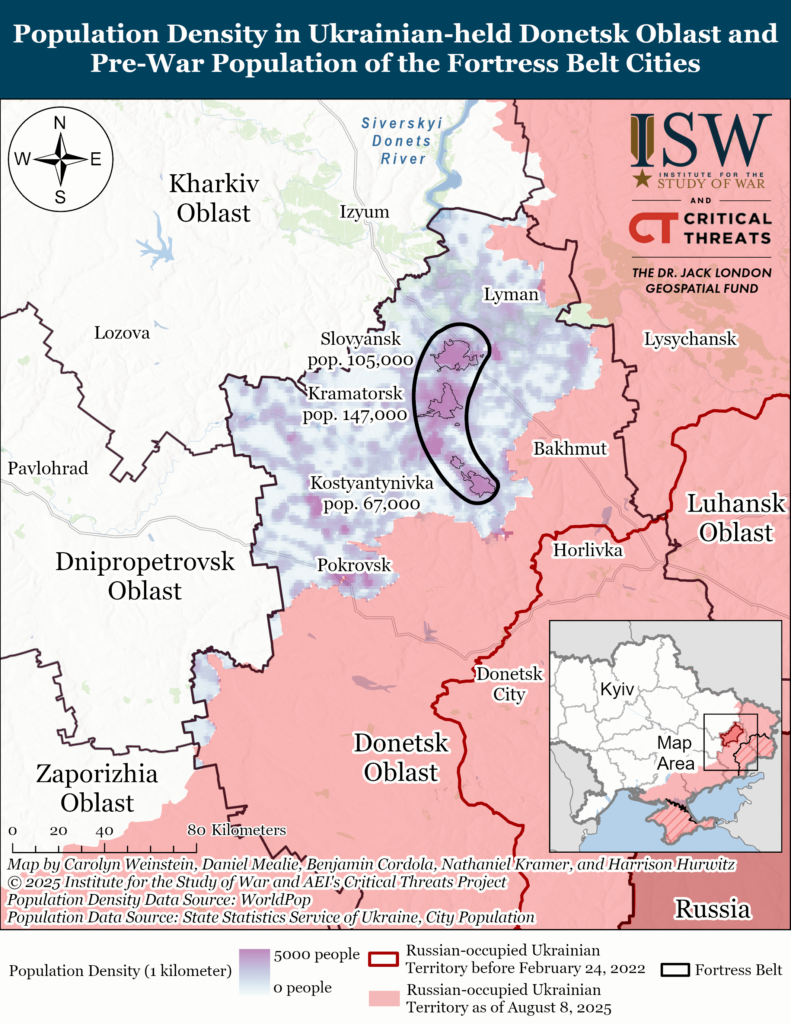
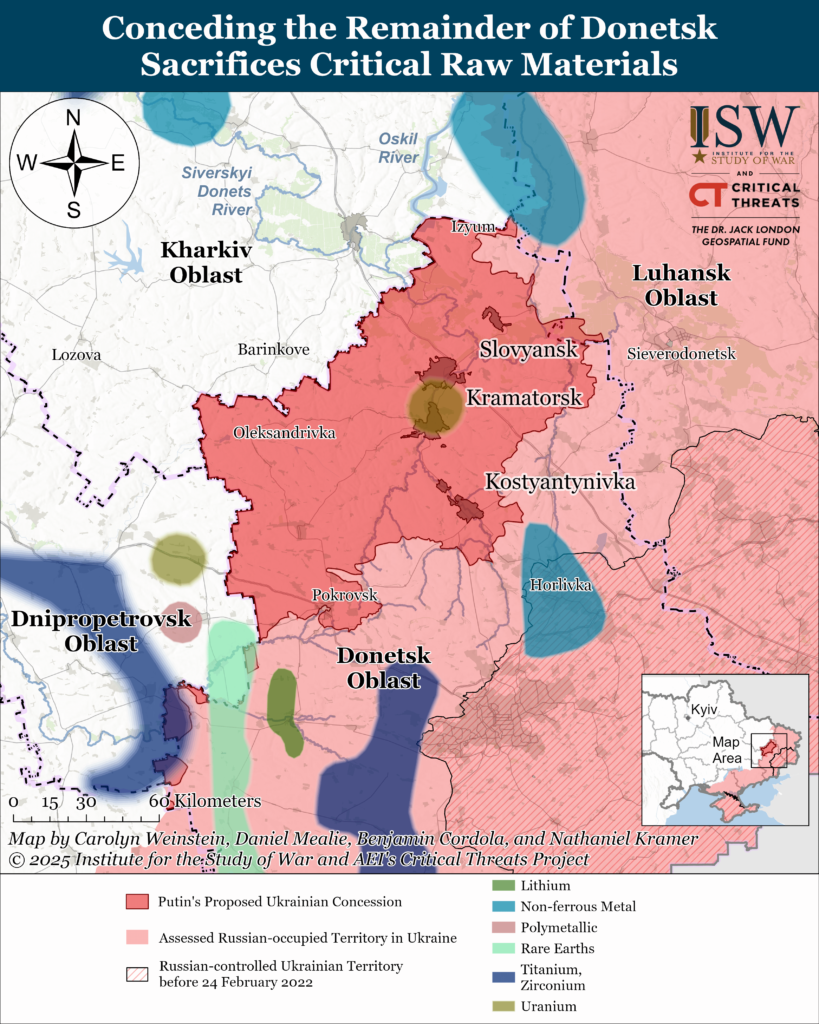
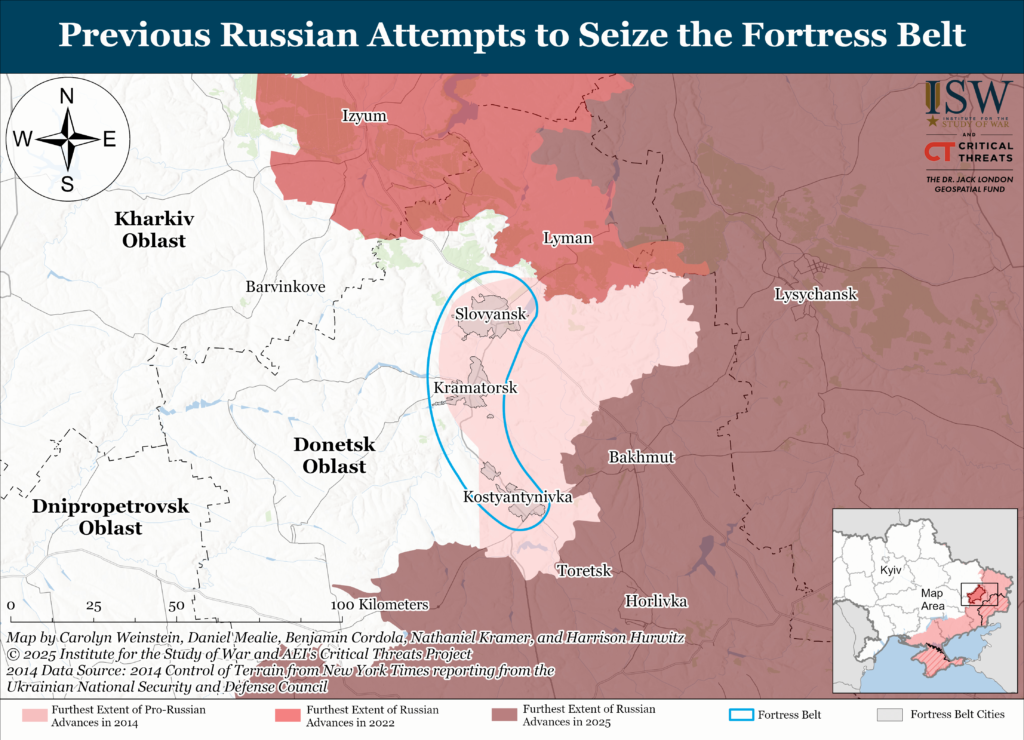
Ceding Ukrainian-held parts of Donetsk Oblast would place Russian forces on the borders of Donetsk Oblast, a position that is significantly less defensible than the current line.
- Allowing Russian forces to take up positions along the Donetsk Oblast border would require Ukrainian forces to urgently build up massive defensive fortifications along the Kharkiv and Dnipropetrovsk oblast border areas, whose terrain is poorly suited to act as a defensive line.
- Potential Ukrainian defensive lines in this area would run through open fields, and natural obstacles such as the Oskil and Siverskyi Donets rivers are too far east to serve as defensive positions for Ukrainian forces defending the Donetsk Oblast border.
- A potential ceasefire along the Donetsk Oblast border would also require large-scale investment in infrastructure compatible with a large-scale, long-term ceasefire monitoring mission.
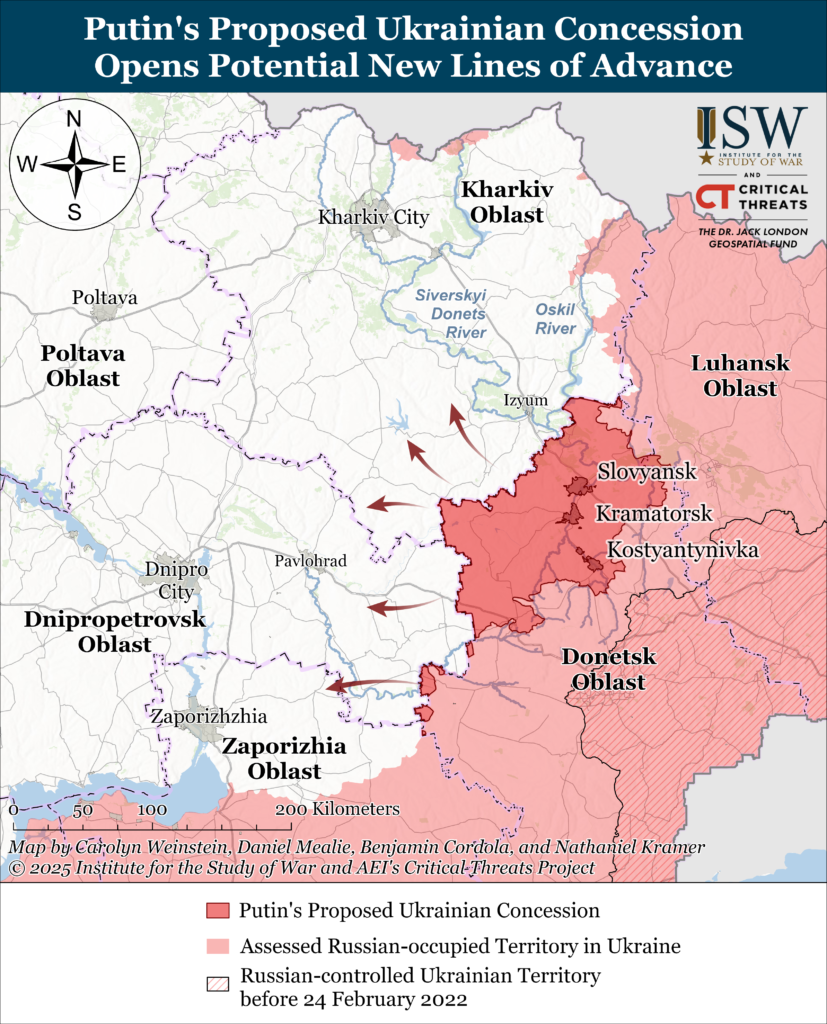
Russian positions along the Donetsk-Kharkiv and Donetsk-Dnipropetrovsk Oblast border areas would provide a much more advantageous launching point for a future Russian offensive into nearby areas of Kharkiv or Dnipropetrovsk oblasts than the current lines.
Forcing Ukraine to concede the remainder of western Donetsk Oblast to Russia would bring Russian forces 82 kilometers further west in Ukraine (roughly 51 miles, or about the distance from downtown Manhattan, New York to Trenton, New Jersey).
Conceding Lyman, Donetsk Oblast to Russian occupation would set favorable conditions for the Russians to attack Ukrainian positions in Kharkiv Oblast on the east bank of the Oskil River in renewed fighting. Russian forces could then attempt to invert their 2022 efforts and leverage Slovyansk and further advances along the E-40 Kharkiv City-Novoshakhtinsk highway to attack Izyum, Kharkiv Oblast, from the south, putting Russian forces roughly 20 kilometers (12.4 miles, about the distance between Washington D.C. and Gaithersburg, Maryland) from the key city of Izyum.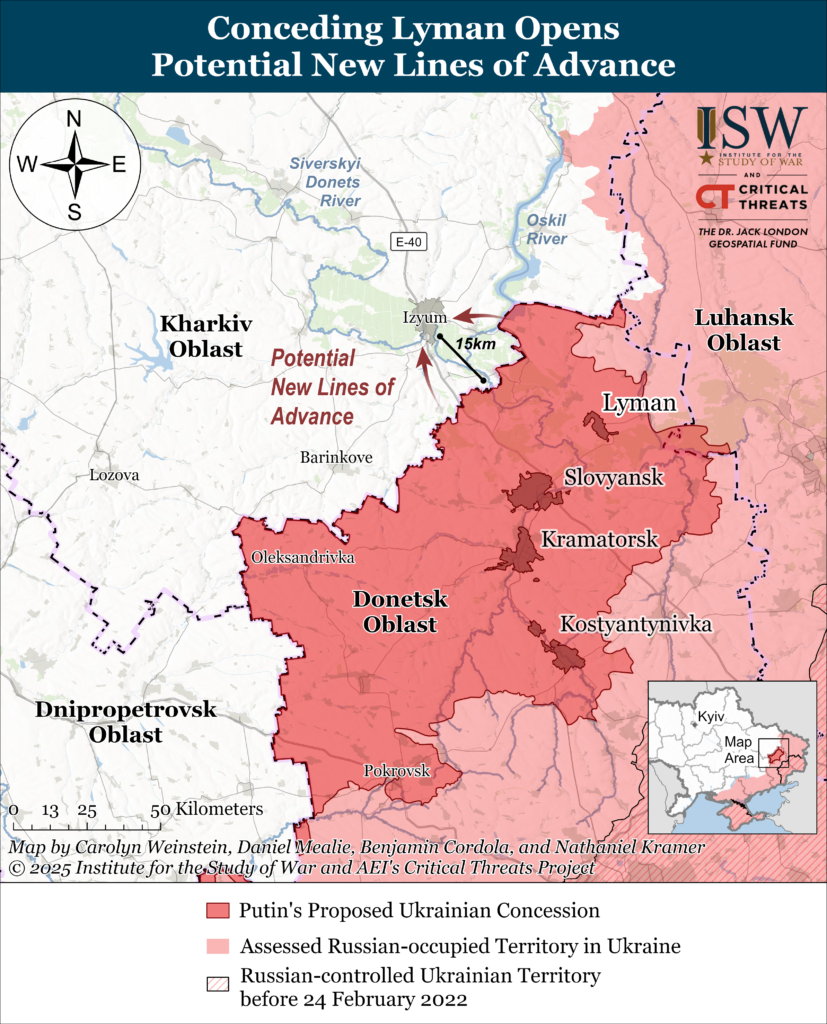
Russian forces also hold limited positions along the Dnipropetrovsk Oblast border southwest of Pokrovsk, but ceding the remainder of Donetsk Oblast would allow Russian forces to avoid completing their ongoing costly efforts to envelop Pokrovsk and Myrnohrad. Russian forces would also avoid having to fight through Ukraine's westernmost Dobropillya-Bilozerske-Novodonetske-Oleksandrivka defensive line, which also runs north to south, similar to the fortress belt. Conceding the remainder of Donetsk Oblast would thus also provide Russian forces more advantageous positions from which to attack into Dnipropetrovsk Oblast.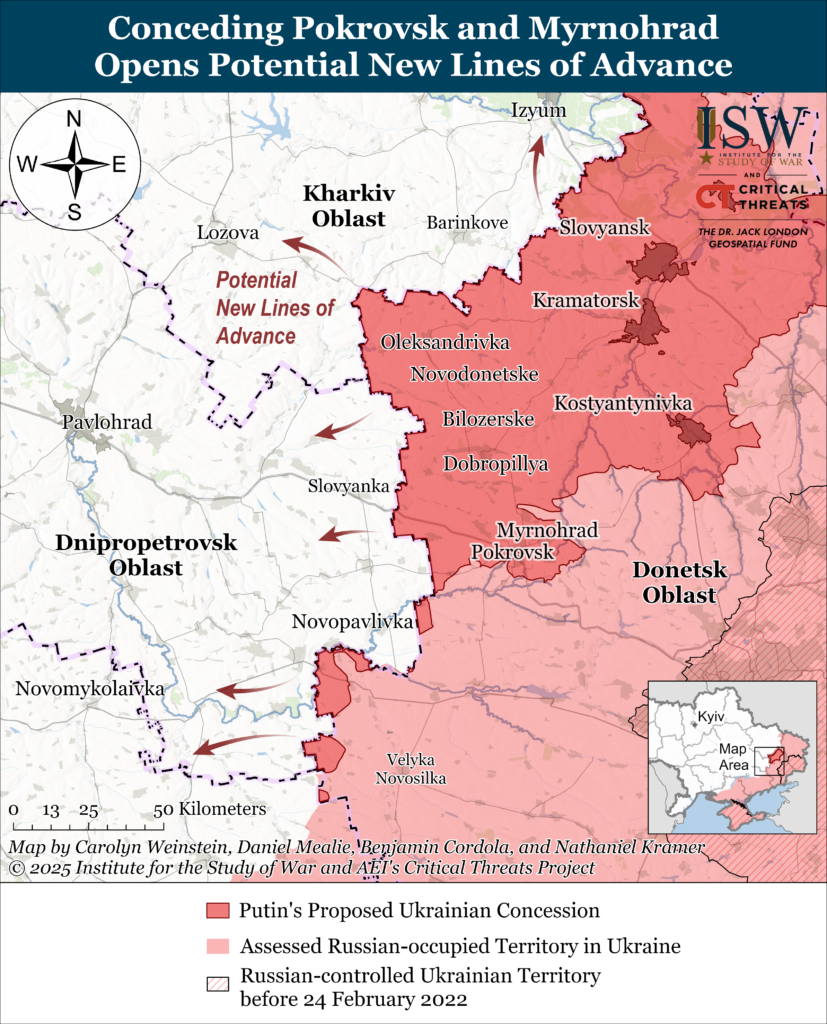
Putin’s reported proposal underscores his uncompromising demands for Ukraine’s capitulation and continued disinterest in good-faith negotiations.
Putin stated on August 1 that the conditions laid out in his June 2024 speech “certainly” remain the same. Putin demanded in June 2024 that any peace agreement must address the “root causes” of the war and provide for Ukraine's demilitarization, denazification, and alliance neutrality. Putin effectively demanded the removal of the current legitimate Ukrainian government and the establishment of a pro-Russian proxy government in Kyiv.
Putin has since consistently demanded that Ukraine concede all of Donbas and “Novorossiya,” referring to occupied and non-occupied parts of Donetsk, Luhansk, Kherson, and Zaporizhia oblasts as a prerequisite for any sort of negotiations with Ukraine.The precise terms of Putin’s proposal remain unclear because of confusion in the Trump Administration’s reports of it.
US officials have reportedly said variously that Putin offered to withdraw from Zaporizhia and Kherson Oblasts in exchange for the remainder of Donetsk Oblast, then corrected that statement to say that Putin was offering only to freeze the lines in Zaporizhia in Kherson.
US officials also reportedly said that Putin offered to withdraw from Sumy and Kharkiv Oblasts.The one condition common to all reports of Putin’s position is the demand that Ukraine withdraw from the remainder of Donetsk Oblast, with all the advantages for Russia and disadvantages for Ukraine outlined above.
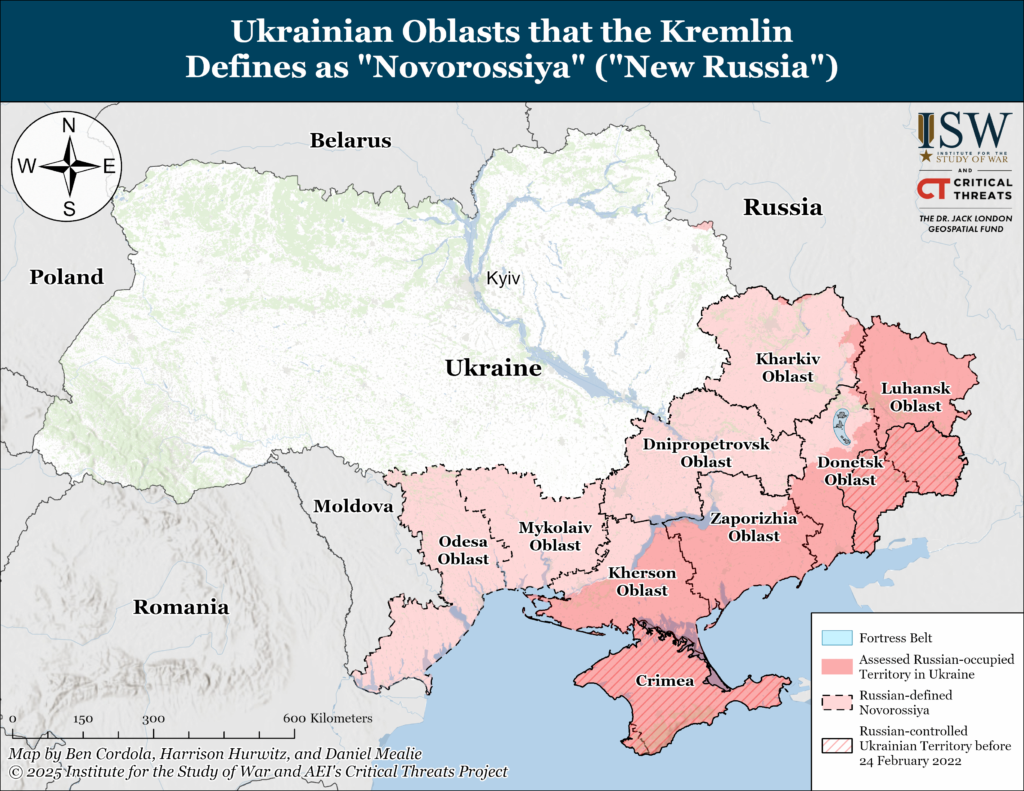
 Eurasia Press & News
Eurasia Press & News


